Tales of recovery: Eastern bluebird
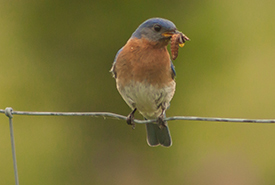
Eastern bluebird (Photo by Cameron Curran/NCC staff)
There is perhaps no other bird that has endeared itself into our popular culture as the bluebird. It’s the helpful feathered friend in Snow White, Sleeping Beauty and Cinderella. Bluebird is in the lyrics of over 500 songs, performed by artists such as Judy Garland, Led Zeppelin or Louis Armstrong. It’s also an easy bird to identify. Even if you’d never seen a bluebird before and were asked to guess the name, you’d probably get it right. It’s good that so many people know about the bluebird, because not that long ago it needed our help.
There are three bluebird species in North America: eastern, western and mountain. The eastern bluebird can be distinguished from its cousins by its rusty-coloured breast and throat. In Canada, it ranges from Nova Scotia to Saskatchewan.
At the dawn of the 20th century and into the 1950s, the eastern bluebird remained common throughout most of its range. Like many species that prefer open areas, it probably even benefitted from European colonization, as forests became pastures, fencerows and orchards. Eastern bluebirds rely on holes in trees to nest, often using cavities created by woodpeckers. The family farm, with its patchwork of different habitats, was ideal for bluebirds. But as agricultural land use intensified, so did the loss of old trees and fence posts that it used for nesting. Growing populations of non-native European starlings and house sparrows also created intense competition for the remaining nesting cavities.
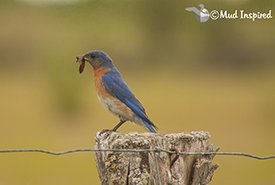
Male eastern bluebird ready to enter a near by nesting box to feed its chicks (Photo by 2014 MudInspired.com)
By the early 1960s, there was growing concern that the eastern bluebird was declining. In the 1970s and 80s, it was on Audubon Society's Blue List of declining species. In Canada, it was assessed as rare by the Committee on the Status of Endangered Wildlife in Canada (COSEWIC) in 1984. Bluebird numbers had fluctuated in the past, but there was concern that because of habitat loss and increasing competition for nesting sites their numbers might not rebound. It was looking like many people might only experience the bluebird in songs and Disney cartoons.
Mobilizing quick action
The prospect of losing a popular and iconic species created a lot of public concern. Books were written about the bluebird and its plight. This concern mobilized quick action. This action was not primarily from governments or even conservation groups, but by thousands of individuals. They built bird houses. Lots of them.
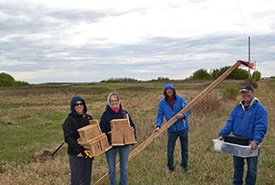
All hands on deck to install nest boxes for the eastern bluebird’s western cousin, the mountain bluebird at the Edenwold property, SK. (Photo by NCC)
European starlings and house sparrows had drastically changed the avian neighbourhood for eastern bluebirds. Even if eastern bluebirds could fend off the new competition, it took a lot of time and energy. The solution was to provide them with bluebird-exclusive houses. Nesting boxes with smaller holes can help keep starlings out. Location and timing are also important strategies for excluding these non-native birds. Dozens of bluebird societies were established across eastern North America to promote their conservation and the construction of nesting boxes.
Bird house benefits
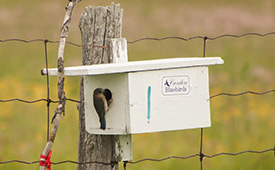
An eastern bluebird at a nest box in Rice Lake Plains, ON. (© Cameron Curran)
Bluebirds quickly moved into these new bird houses. In addition to improving nesting success, “trails” of nest boxes allowed us to better monitor and study eastern bluebirds. By 1996, eastern bluebird was taken off the COSEWIC list because the population has increased in large part as a result of a successful nest box program. Eastern bluebirds still face many issues related to habitat loss. They are also susceptible to extreme and unusual weather events, and these are increasing as a result of climate change. In many places, they have become a conservation-dependent species and rely on nest boxes to maintain their numbers.
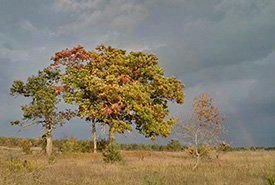
Hazel Bird Nature Reserve, ON (Photo by Mark Stabb/NCC staff)
Today, it’s easy to spot eastern bluebirds on the Nature Conservancy of Canada’s (NCC’s) Hazel Bird Nature Reserve on the Rice Lake Plains. Black oak savannahs and tallgrass prairie habitats on this property are not only globally imperiled, they provide excellent habitat for the eastern bluebird. The Hazel Bird Nature Reserve and other Rice Lake Plains properties have been supported by funding from the Government of Canada, the Ontario Trillium Foundation and many other donors.
In addition to providing habitat, this property includes of one of Ontario’s oldest bluebird trails. These pioneering efforts were led by Hazel Bird, a local naturalist who worked with landowners to create a network of over 400 nesting boxes. In honour of Hazel Bird, NCC not only named a property after her but has been hosting an annual Hazel Bird Day to celebrate migratory birds and the people who are helping conserve them.
Examining our relationship with species
The lesson of the eastern bluebird is that our collective actions can result in significant impacts. This is certainly not the case for every endangered or declining species. I can’t do much in my community to directly help conserve wolverines or whooping cranes. But I plant milkweed for monarchs and improve the habitat in my backyard for migrating songbirds. The recovery story of the eastern bluebird is important because it changes the narrative of our human relationship with other species. We can be destroyers of nature; a force that creates a less diverse and homogenized natural world. But we can also be restorers of nature, creating a richness and abundance of life.
The bluebird was helped in its recovery because people knew about it. While we may never have a civil society dedicated to the eastern hog-nosed snake or lakeside daisy, there are many Canadian species that need our help now. All species have their own stories that we need to know and share — their quirky habits, unique life cycles and increasing their fight for survival in the world that is rapidly changing. We can’t build houses for all of them, but we can help protect their homes.
Resources
Nash, C.W., Manual of the Vertebrates of Ontario. 1908, Toronto: Department of Education.
Taverner, P., Birds of western Canada. Canada Department of Mines, Victoria Memorial Museum. Bulletin, 1928(41).
Arbib, R., Announcing—the blue list:“an early warning system” for birds. American Birds, 1971. 25: p. 948-949.
Tate Jr, J. and D.J. Tate, The blue list for 1982. Amerrican Birds, 1982. 36: p. 126-135.
Zeleny, L., The Bluebird: How you can help its fight for survival. 1976, Bloomington, IN: Indiana Univ. Press.
Sauer, J.R. and S. Droege, Recent population trends of the Eastern Bluebird. The Wilson Bulletin, 1990: p. 239-252.


